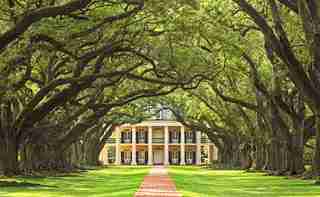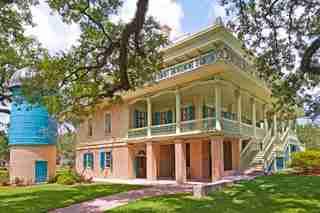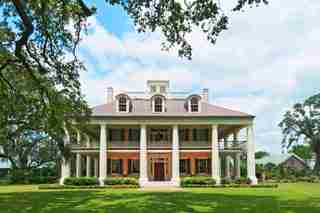
Here, we’ve rounded up some of the most glorious Southern homes of a bygone era, from the majestic Oak Alley just outside New Orleans with its iconic allée of moss-covered trees to the quirky octagonal Longwood in Natchez, Mississippi—and they are all open to the public and available for tours. Built to exhibit the wealth of plantation owners, these homes feature many interesting architectural elements, including a Byzantine dome and an army of Corinthian columns, that hint at the wide array of design inspiration. These properties not only give us an intimate look at how people once lived in the region, they’re also extraordinary examples of American architecture during a specific moment in history. Shown: Perhaps the most recognizable plantation—frequently used as a movie set, it’s known for the majestic row of oak trees leading up to the home— Oak Alley sits grandly on the bank of the Mississippi just outside of New Orleans. The home boasts stunning Greek Revival architecture with 28 Doric columns symbolizing the number of oak trees on the property.

San Francisco sits 40 miles upriver from New Orleans. Although construction began in 1853, the home’s “Steamboat Gothic” style and bright color scheme are certainly not typical of the period.

When the Louisiana plantation was completed in 1828, Houmas House was much admired for its sweeping galleries and the belvedere that crowns the structure. There are also two rare garçonnières , one of which now houses a handsome bar with an extensive bourbon collection.
Farther north in South Carolina, about 15 miles south of Charleston, Drayton Hall is located on the Ashley River. Built in the 1740s with porticoes and fine interior plasterwork, it’s a beautiful representation of Palladian architecture.
One of the oldest residences in the mix, Magnolia Plantation dates from 1676. Although the original manor was burned during the Civil War, it has since been reconstructed and restored. The most notable feature of the home is its expansive gardens, which include an indoor tropical oasis and Cypress Lake, a gathering of 100-year-old bald cypress trees.
Located in downtown Natchez, Mississippi, the 1859 Stanton Hall takes up a full city block. The estate was occupied by Union troops during the Civil War, but its remarkable details, including the signature Corinthian columns and cast-iron balconies, are still intact.
Completed in 1823, Rosalie Mansion features a Greek Revival–style center hall, columned exterior, and front portico, becoming a template for the architecture of many other Southern plantations. Situated on the bluffs in Natchez, the home is a prominent landmark as you drive into downtown.
The 15,000-square-foot Melrose is another pinnacle of Greek Revival architecture in Natchez, with grand Doric columns and a triangular pediment that resembles a temple. Inside, the rooms still contain some of the original furnishings. The property spans an impressive 80 acres, which are maintained by the National Park Service.
Natchez’s Longwood plantation is interesting for not only its distinctive octagonal design and Byzantine-style dome, but also for its history. The upper floors were never finished, and just nine rooms, all belowground, were completed out of the 32 planned by Philadelphia architect Samuel Sloan.
